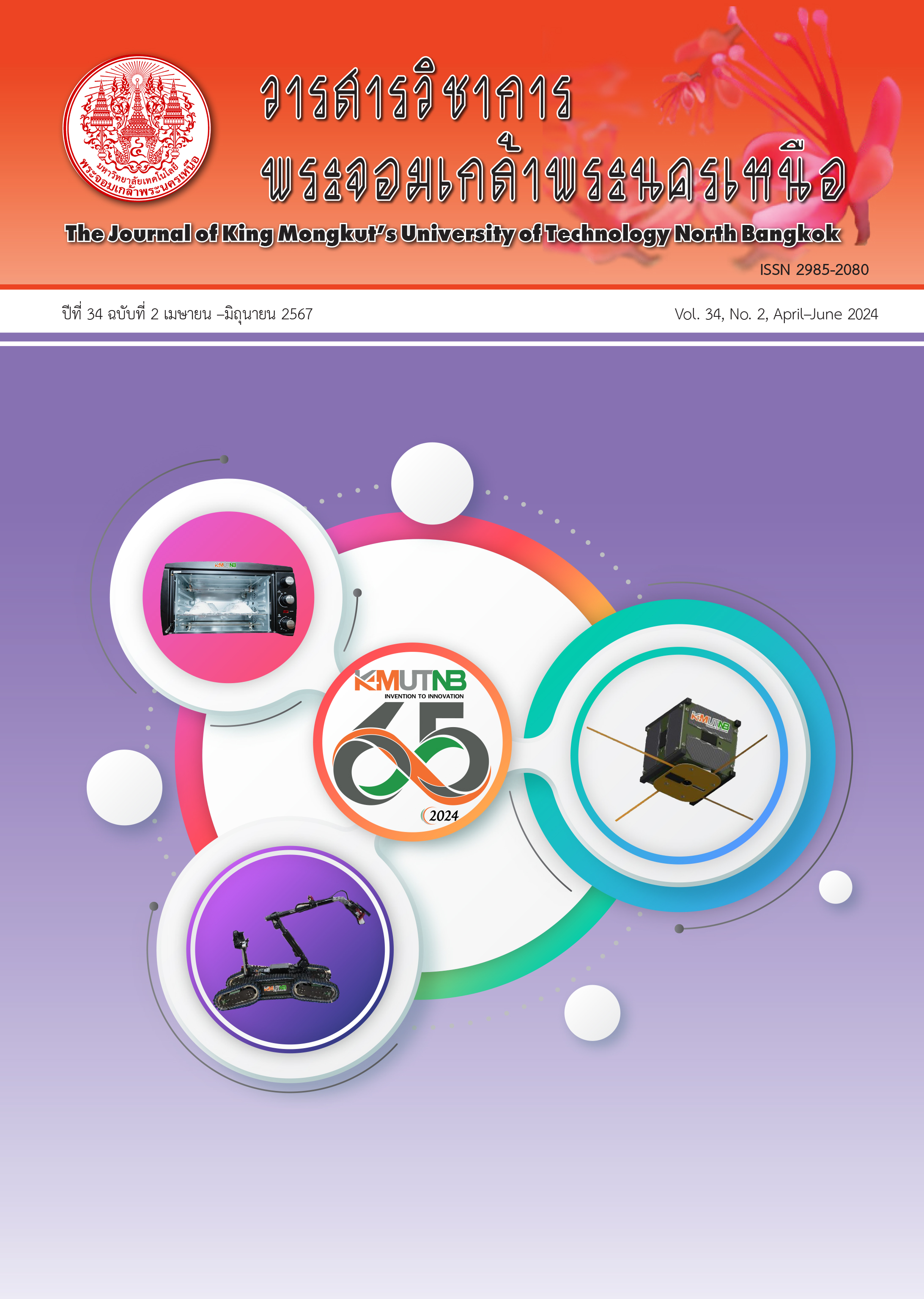การพัฒนาสมการแสดงคุณสมบัติที่ขึ้นกับเวลาของเกลือหินแบบทรานซ์เวอร์สไอโซทรอปี
Main Article Content
บทคัดย่อ
งานวิจัยนี้มีวัตถุประสงค์เพื่อหาคุณสมบัติที่ขึ้นกับเวลาของเกลือหินชุดมหาสารคามที่มีลักษณะแบบทรานซ์เวอร์สไอโซทรอปี แบบจำลองการคืบของหินแบบทรานซ์เวอร์สไอโซทรอปีถูกพัฒนาจากสมการของ Amadei ให้อยู่ในรูปค่าคงที่ของเบอเกอร์และมุมการวางตัวของชั้นหิน งานวิจัยนี้ได้ทดสอบการคืบในแกนเดียวกับตัวอย่างเกลือหินที่มีระนาบการวางตัวของชั้นหิน (β) ผันแปรตั้งแต่ 0 45 60 75 ถึง 90 องศา ตามลำดับ เพื่อเปรียบเทียบกับแบบจำลองที่ถูกพัฒนาขึ้น ผลการทดสอบระบุว่า ความเครียดในแนวแกนและแนวด้านข้างมีค่าสูงสุดเมื่อแนวแรงกดตั้งฉากกับระนาบของชั้นหิน (β = 0º) และมีค่าต่ำสุดเมื่อแนวแรงกดขนานกับระนาบของชั้นหิน (β = 90º) การวิเคราะห์เชิงถดถอยระบุว่าสัมประสิทธิ์ความยืดหยุ่น ความหนืดเชิงยืดหยุ่น และความหนืดเชิงพลาสติกมีค่าสูงขึ้นเมื่อมุม β มากขึ้น แบบจำลองการคืบของหินแบบ ทรานซ์เวอร์สไอโซทรอปีสามารถคาดคะเนการเปลี่ยนแปลงรูปร่างและหาค่าสัมประสิทธิ์ความยืดหยุ่นปรากฏและอัตราส่วนปัวส์ซองปรากฏเชิงเวลาของเกลือหินภายใต้สภาวะที่ชั้นหินมีระนาบการวางตัวแตกต่างกันได้ และสามารถใช้ในการคาดคะเนการเปลี่ยนแปลงรูปร่างเชิงเวลาของโครงสร้างใต้ดิน เช่น เสาค้ำยันและผนังด้านข้างของเหมืองเกลือหินได้
Article Details

อนุญาตภายใต้เงื่อนไข Creative Commons Attribution-NonCommercial-NoDerivatives 4.0 International License.
บทความที่ลงตีพิมพ์เป็นข้อคิดเห็นของผู้เขียนเท่านั้น
ผู้เขียนจะต้องเป็นผู้รับผิดชอบต่อผลทางกฎหมายใดๆ ที่อาจเกิดขึ้นจากบทความนั้น
เอกสารอ้างอิง
M. K. Jeremic, Rock Mechanics in Salt Mining, A.A. Balkema: Netherlands, 1994.
N. Sukjaroen, T. Thongprapha, K. Artkhonghan, and K. Fuenkajorn, “Effects of transverse isotropy on compressive strength and elastic properties of rock salt,” Engineering Journal of Research and Development, vol. 32, no. 1, pp. 47–54, 2021 (in Thai).
R. McLamore and K.E. Gray, “The mechanical behavior of anisotropic sedimentary rocks,” Journal of Engineering for Industry, vol. 89, no. 1, pp. 62–73, 1967.
A. A. Al-Harthi, “Effect of planar structures on the anisotropy of Ranyah sandstone,” Saudi Arabia. Engineering Geology, vol. 50, no. 1–2, pp. 49–57, 1998.
K. Colak, and T. Unlu, “Effect of transverse anisotropy on the Hoek-Brown strength parameter 'mi' for intact rocks,” International Journal of Rock Mechanics and Mining Sciences, vol. 41, no. 6, pp. 1045–1052, 2004.
O. Saeidi, V. Rasouli, R. G. Vaneghi, R. Gholami, and S. R. Torabi, “A modified failure criterion for transversely isotropic rocks,” Geoscience Frontiers, vol. 5, no. 2, pp. 215–225, 2014.
L. Yun-si, Z. Xiao, and Y. Quan, “The five elastic parameters for the anisotropy of slate under the influence of different bedding orientations,” Electronic Journal of Geotechnical Engineering, vol. 17, pp. 3695–3707, 2012.
H. Kim, J. W. Cho, I. Song, and K. B. Min, “Anisotropy of elastic moduli, P-wave velocities, and thermal conductivities of Asan Gneiss, Boryeong Shale, and Yeoncheon Schist in Korea,” Engineering Geology, vol. 147, pp. 68–77, 2012.
C. Cheng, X. Li, and H. Qian, “Anisotropic failure strength of shale with increasing confinement: behaviors, factors and mechanism,” Materials, vol. 10, no. 11, pp. 1310, 2017.
T. Thongprapha, K. Tengpakwaen, J. J. K. Daemen, and K. Fuenkajorn, “Effect of confining pressures on transverse isotropy of Maha Sarakham salt,” International Journal of Rock Mechanics and Mining Sciences, vol. 152, 2022.
R. K. Dubey, “Bearing of structural anisotropy on deformation and mechanical response of rocks: An experimental example of rocksalt deformation under variable compression rates,” Journal of the Geological Society of India, vol. 91, pp. 109–114, 2018.
R. K. Dubey and V. K. Gairola, “Influence of structural anisotropy on creep of rocksalt from Simla Himalaya, India: An experimental approach,” Journal of Structural Geology, vol. 30, no. 6, pp. 710–718, 2008.
B. Amadei, “Importance of anisotropy when estimating and measuring in situ stresses in rock,” International Journal of Rock Mechanics and Mining Sciences and Geomechanics Abstracts, vol. 33, no. 3, pp. 293–325,1996.
Y. H. Hatzor and E. P. Heyman, “Dilation of anisotropic rock salt: Evidence from mount sedom diapir,” Journal of Geophysical Research: Solid Earth, vol. 102, no. B7, pp. 14853–14868, 1997.
J. Zhang, X. Zhang, Z. Huang, and H. Fu, “Transversely isotropic creep characteristics and damage mechanism of layered phyllite under uniaxial compression creep test,” Environmental Earth Sciences, to be published, 2021.
G. Xu, C. He, J. Yan, and G. Ma, “A new transversely isotropic nonlinear creep model for layered phyllite and its application,” Bulletin of Engineering Geology and the Environment, vol. 78, no. 7, pp. 5387–5408, 2019.
G. Luo, W. Yang, C Bo, L. Zhang, K. Duan, W. Jing, and Y. Zhao, “Viscoelastic analysis of the creep characteristics of interlayered rock specimens under uniaxial compression,” Mechanics of Time-Dependent Materials, vol. 25, no. 1, pp. 37–60, 2021.
N. A. Ghavidel, A. Nazem, M. Heidarizadeh, M. Moosavi, and H. Memarian, “Identification of rheological behavior of salt rock at elevated temperature, case study: Gachsaran evaporative formation, Iran,” presented at ISRM Regional Symposium-EUROCK, Vigo, Spain, May. 26–28, 2014.
W.N. Findley, J.S.Lai, and K. Onaran, Creep and relaxation of nonlinear viscoelastic materials, Dover, NewYork, 1976.
M. Jandakaew, “Stress-path dependency of rock salt,” presented at the First Thailand Symposium on Rock Mechanics, Greenery Resort, Khao Yai, Nakhon Ratchasima, Thailand, sep. 13–14, 2007.
Standard test methods for creep of rock core under constant stress and temperature, ASTM D7070-08, 2021.
J. C. Jaeger and N. G. W. Cook, Fundamentals of Rock Mechanics, London: Chapman and Hall, 1979.
L. Wendai, “In 13 chapters. SPSS for windows: Statistical analysis,” in Regression analysis, linear regression and probit regression, Beijing, China: House of Electronics Industry, 2000.
K. F. Riley, M. P. Hobson, and S. J. Bence, Mathematical Methods for Physics and Engineering, Cambridge: Cambridge University Press, 1998.
C. Wu, Q. Chen, S. Basack, and S. Karekal, “Laboratory investigation on rheological properties of greenschist considering anisotropy under multi-stage compressive creep condition,” Journal of Structural Geology, vol. 114, pp. 111–120, 2018

